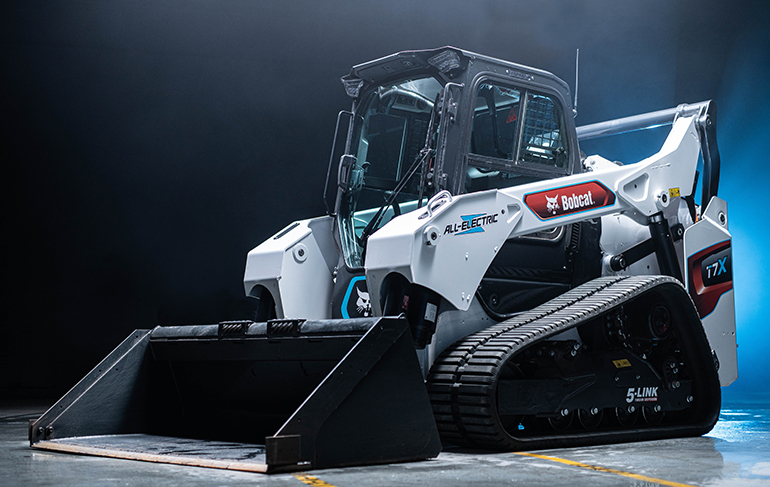Up until now, mobile electrification efforts were a shot across the bow of the hydraulics industry. Doosan Bobcat just hit it broadside. At this year’s CES 2022 in Las Vegas, the company premiered a new all-electric Bobcat T7X compact track loader, said to be the first machine of its kind to be fully electric and which completely eliminates the hydraulic system.

“Doosan Bobcat is at the forefront of innovation, and we are proud to debut the all-electric technology of the T7X to help customers maximize both sustainability and productivity,” said CEO Scott Park.
In terms of sustainability, that may be true, particularly if the electricity comes from renewable sources, not coal-burning power plants. With zero emissions it will undoubtedly run cleaner and quieter than a diesel counterpart. This type of compact off-road equipment is well-suited for operations where municipal regulations prohibit diesel machines; where noise or exhaust are an issue, say in congested urban settings; and for indoor work where it could reduce or eliminate manual labor.
The traditional hydraulic work group has been completely replaced with an electrical drive system consisting of electric ball-screw actuators and electric drive motors. The electric systems are more efficient than conventional hydraulics and should reduce maintenance costs. And they may offer finer control and smoother motion, and simplify condition monitoring.
In terms of productivity, however, the jury is still out. Bobcat claims the T7X provides high-performance torque and more power than similar diesel-fueled track loaders. But a
62 kW lithium-ion battery powers electric actuation and propulsion. As industry expert Joe Kovach of KoMotion Technologies noted during WTWH Media’s Engineering Week roundtable on mobile electrification, the energy content of a gallon of diesel is about 38 kW. You don’t have to be a math major to understand why, with a low energy density, the T7X can only work continuously for about four hours, at best. And for the same operating capacity, it weighs 20% more than similar standard machines.
Then there’s compliance. In hydraulics, the fluid acts like an elastic spring. That opens the opportunity to dampen oscillations that are transmitted to the cab. Electrics don’t offer this benefit. “Compliance is a great thing to have,” said Kovach. Otherwise, working in the field, digging and hitting rocks sends tremendous shock loads through the system to the detriment of operator comfort and safety.
Ball screws have additional issues, he continued. They are not jam tolerant and most are not easily back-drivable, which means you can’t recover energy. Hydraulics can build in energy recovery, say when lowering a large load. Ball screws also have to take extreme measures to protect against dirt and contamination or else they quickly wear out. And when they’re run at low speeds, reliability and life are concerns.
And then there’s cost. Batteries are still quite expensive, and inverters and electric motors aren’t cheap. Some companies indicate that right now, building a comparable electric machine costs two to three times more than a diesel model. And mobile manufacturers don’t have the luxury of high production volumes to drive down price, as in the automotive industry. Today, OEMs are accepting the reality that electric vehicles are more expensive, and are focused on efficiency and less maintenance in hopes of lowering total operating costs over the long term.
Many people want to go all-electric in principle. “But to just jump on the electrification bandwagon and put batteries on all construction equipment is kind of naive. There isn’t one size that fits all,” said Kovach.
To gain widespread acceptance, electrics need a breakthrough in battery technology. And hydraulics needs to raise the bar on efficiency, building on new developments like floating-cup and digital-displacement pumps, and low-loss internal gear designs. Hybrid electric-hydraulic systems could offer the best of both worlds, to the ultimate benefit of customers and the environment.
Filed Under: Mobile Hydraulic Tips, Trending